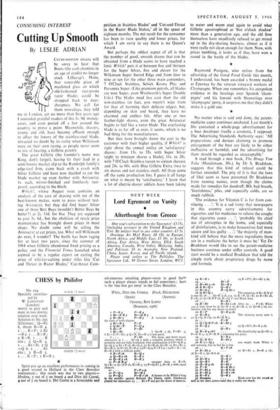CHESS by Philiclor
No. 294.
Specially contribu- ted by
W. LANGSTAFF
(London) WHITE to play and mate in two moves; solution next week. Solution to No. 293 (Merman) : Q—Kt 6, threat R—B 4.
...RxP; 2 Kt —B2. t...RxB; 2 R x R. r . . . R else ; 2 Q—K 4. x . . Kt x R; 2Q —Q 6. r . . Kt else; 2 R—B 5. CLACK (7 men) WHITE (7 men)
.KxP; 2 R—B 5.
Spain put up an excellent performance in coming in a good second to Holland in the Clare Benedict tournament ; this result was due to two players— Medina, 5 out of 5 on board 4 and Diez del Corral, 4 out of 5 on board 2. Del Corral is a formidable and
adventurous attacking player—even in good form such a player always stands to fail sometimes ; here is the 'one that got away' in the Clare Benedict.
White, DIEZ DEL CORRAL Black, DUCKSTEIN
(Spain) (Austria)
Opening, RUY LOPEZ (Brunnen, 1966)
z P—K P—K 4 z Kt—It 3 Kt—Q B 3
3 B—Kt g P—B 4 A variation thoroughly to the taste of both players.
4 Kt—B 3 P x P
QKtx P P—Q 4
6 Kt x P PxKt
7 Kt x Kt7 Q—R 5 ch, P—Kt 3; 13 Kt x P, P x Kt; 9 Q xit.,101—B 3 is less good. 7 . P x Kt The main, and more usual, alternative is 7 . • Q—Q 4 with a complex position which is probably still not fully evaluated. One continuation is 8 P—Q__13 4, 3; 9 Kt xP cb, B—Q 2; B xB ch, Q xB; Kt—Kt 5, Kt— 3; 12 0-0, B—B 4; 13 P—Q 4,P xP e.p.; 14 R— K ch, K—B a with a difficult game.
8 BxPch B—Q 2
9 Rack K—K 2 zo Ks ch B—K 3
rz P—K B 41• 2 stronger than it B x R, Tc1152 Q xn P ch, K—B 3; 13 P—Q Kt 3, B—K with equal
PxPe.p.
22 pal Kt—B3 P—B 7 ch A finesse to fix White's king
13
in the middle: against Rolland Me Havre, 1966) Dfickstem played the immediate 13 . Kt xP and got the worst of matters. 14 K—K 2 . . . 54 K x P??, Kt—Kt 5 ch.
r4 • • • Kt x P rg B—Kt 5 ch Kt—B 3 z6 K R—Q z Q—B z r7 R—Q 3 R—Q Kt z
r8 Q R—Q z . . . The tempting I8 R—K B 3? is met by 18 . .. Q—R 3 ch, e.g. 59 K xP, Q xB; 20 B x Kt ch, P xB; 21 Q x K B P ch, K—Q 2! and Black wins.
z8 . .K—B 2 19 Bx*Kt B—Kt 3 ch After 19 . . . P xB; White can at least draw by 20 Q—R 5 ch, K—K 2; 21 Q—B 5 ch, etc. Neither side has any desire to draw!
20 K xP Q—B 4 ch 21 B—B 3 . . . The drawing move now is
22 Q xQ, B xQ; 22 R—K B 3.
21 . . . PxB 22 QxQBPch .K—Kt 3 23 R—Q 5• • • 23 Q x R??, B—B 4 ch. Q—B z 24 B—K 4 ch? . . . He should play 24 Q—Kt 3, P—K R 4; 25 P—K R 3 regaining his piece.
24 • • • K—R 3 25 Q—K B 7 R—Kt 3
26 R (1)—Q 3 . . you might think White is i still winning, but in fact. he is lost.
26.. . Q x P ch 27 K—Kt 3 . . . 27 K—Kt a, B—B 4 ch;
28 K—R i, Q--B 8 ch Q—K 7 28 B—B 3 Q—K 3!
29 Q—B 7 BxB 3o Q—B 4 ch K—Kt 2 31 PxB R—K Kt z
32 P—Kt 3 Q—K 8 ch 33 K—Kt 4 K—R z ch 34 K—R 3 Q—K 3
well Resigns • . • Black now has the attack as well as the extra piece—and this is really too much.





























 Previous page
Previous page